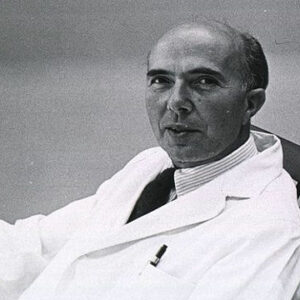Renato Dulbecco was an Italian American virologist who earned a share of the Nobel Prize for Physiology or Medicine in 1975. A medical researcher, he made substantial work on oncoviruses, the viruses that may cause cancer when they infect animal cells. A good student from a young age, he was strongly inspired by an uncle who was a distinguished physician. Motivated by him, Dulbecco chose to study medicine at the University of Turin and graduated in morbid anatomy and pathology under the direction of Professor Giuseppe Levi. He served in the Italian army in World War II, but subsequently joined the resistance. After the war, he traveled to the United States and began his study on viruses. After working with Salvador Luria on bacteriophages, he proceeded to Caltech on the invitation of Max Delbrück and joined his group. It was here that he began his fundamental study on animal oncoviruses, specifically the polyoma family. Over the course of his career, he cooperated with numerous other talented scientists like his student Howard Temin and the cancer biologist and virologist Marguerite Vogt. While working at the Imperial Cancer Research Fund (now the Cancer Research UK London Research Institute), he was a part of the team that initiated the Human Genome Project.
Childhood & Early Life
Renato Dulbecco was born on February 22, 1914, in Catanzaro, Italy, to a Calabrese mother, Maria, and a Ligurian father, Leonardo. His father, a civil engineer, was summoned to serve in the army during the World War I. He grew up in Liguria, in the seaside city Imperia, where he spent a lot of his spare time at a tiny meteorological observatory. Visits to the observatory ignited his interest in physics.
A excellent student, he graduated from high school in 1930, at the age of barely 16. Even though he was highly talented at mathematics and physics, he opted to pursue medicine. His choice was significantly impacted by the respect he had for his uncle who was a doctor.
He entered the University of Turin where he studied morbid anatomy and pathology under the guidance of Professor Giuseppe Levi. He graduated with an MD in 1936. During his years in Turin he met Salvador Luria and Rita Levi-Montalcini with whom he made long term connections.
Career of Renato Dulbecco
Soon after the completion of his degree he was called up for military duty as a medical officer in 1936 and released in 1938. Italy entered the World War II in 1940 and he was once again called up for military action. Following the collapse of Fascism he joined the fight against the German occupation.
He continued his job at Levi’s laboratory after the war but soon moved for the United States on the invitation of Salvador Luria who was already working there. After working with Luria on bacteriophages for a period, he was recruited by Max Delbrück to join the Caltech in 1949.
In the late 1950s Dulbecco took a student Howard Temin, who combined with a postdoctoral fellow Harry Rubin, demonstrated a significant interest in researching on the Rous Sarcoma Virus. Their work in the tumor virus sectors fascinated Dulbecco and he too began research on an oncogenic virus, polyoma virus.
In 1962, he went from Caltech to the Salk Institute for Biological Studies, then in 1972 to The Imperial Cancer Research Fund (now titled the Cancer Research UK London Research Institute) (now named the Cancer Research UK London Research Institute). He returned to Salk in 1977 and served as its president from 1988 to 1992. He returned back to Italy in 1993 and worked as president of the Institute of Biomedical Technologies at C.N.R. (National Council of Research) in Milan until 1997. He also kept his post on the faculty at Salk.
Major Works of Renato Dulbecco
Dulbecco was a part of the group which produced crucial discoveries on the working of oncoviruses—the viruses that may cause cancer when they infect animal cells. In partnership with Marguerite Vogt he revealed that polyomavirus, which creates tumors in mice, inserts its DNA into the DNA of the host cell following which the host cell undergoes metamorphosis into a cancer cell.
He made important research on breast cancer and established a pioneering approach for recognizing cancer cells by their genetic signature. He was actively interested in the research of the mammary gland cancer stem cells up to till a few months before his death.
Awards & Achievements
The Albert Lasker Award for Basic Medical Research was granted to Dulbecco and Rubin in 1964. Dulbecco, together with Harry Eagle and Theodore T. Puck was won the Louisa Gross Horwitz Prize for Biology or Biochemistry in 1973. Renato Dulbecco, David Baltimore and Howard Martin Temin were jointly won the Nobel Prize in Physiology or Medicine 1975 “for their findings about the interplay between tumor viruses and the genetic material of the cell.”
Personal Life & Legacy
Renato Dulbecco was married twice. His first marriage to Giuseppina Salvo, which produced a son and a daughter, ended in divorce. His second marriage to Maureen Rutherford Muir was a joyful one. The couple has one daughter.
He had a long life and remained involved in research even when he was far into his nineties. He died on February 19, 2012, three days before his 98th birthday.
Estimated Net Worth
The estimated net worth of Renato Dulbecco is not available.


